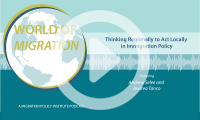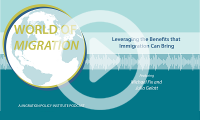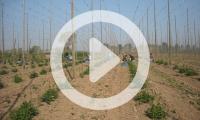Sectoral Employment
Recent Activity
Este seminario web, que presenta el lanzamiento de un informe, examina el potencial de Canadá, México y Costa Rica para expandir los programas de trabajadores temporales para los centroamericanos, ofreciendo un medio importante para convertir algunos flujos irregulares en flujos legales.

With migration a dynamic phenomenon in the Americas, the U.S. government increasingly is realizing that migration management should be viewed in a regional context. This requires a new set of policies and ways of engagement with countries in North and Central America, and beyond, as MPI President Andrew Selee discusses with colleague Andrea Tanco in this episode of our World of Migration podcast.

In this World of Migration podcast episode, MPI Senior Fellow Michael Fix speaks with Senior Policy Analyst Julia Gelatt about the fiscal impacts of immigration, the importance of immigrant integration, how a greater focus on credential recognition could allow immigrants to more fully utilize the academic and professional skills they bring with them, and much more.

Governments are facing urgent pandemic-related questions. One of the more pressing ones: Who is going to harvest crops in countries that rely heavily on seasonal foreign workers? In this podcast, MPI experts examine ways in which countries could address labor shortages in agriculture, including recruiting native-born workers and letting already present seasonal workers stay longer.
At the 15th annual Immigration Law and Policy Conference, held in October 2018, leading experts and government officials discussed the role that immigration is playing in the mid-term elections; how the courts are handling key immigration questions; and recent changes in the U.S. asylum system, border and interior enforcement, and regulations surrounding legal immigration.
Pages
Recent Activity
The COVID-19 pandemic’s impacts on mobility in the Middle East and North Africa were immediate and wide-reaching. These include the world’s largest and most sustained repatriation efforts for stranded migrants, halted and reversed irregular journeys, and a reckoning with some countries’ reliance on foreign labor. This report examines how these impacts varied across countries in this highly diverse region, as well as the uneven recovery.
The story of the COVID-19 pandemic in Europe is chiefly one of challenges to solidarity and coordination. Cross-border movement—even within Europe’s Schengen Area—ground to a halt, and countries took varied approaches to using travel measures in an attempt to slow the virus’s spread. This report explores the pandemic’s impacts on mobility to and within Europe, its challenges to European solidarity, and lessons for future public-health crises.

















Apprenticeship Programs Are a Promising Solution to Bring More Multilingual Workers into Early Childhood Field
Why the European Labor Market Integration of Displaced Ukrainians Is Defying Expectations
Labor Shortages during the Pandemic and Beyond: What Role Can Immigration Policy Play?
The Role of Immigrant Health-Care Professionals in the United States during the Pandemic
A Race Against the Clock: Meeting Seasonal Labor Needs in the Age of COVID-19
Brexit Day—Is This the Dawning of the Age of Immobility?
Will DREAMers Crowd U.S.-Born Millennials Out of Jobs?
All Eyes Turn to Congress, Following Trump Decision to Terminate DACA Program
The Field of Migration Studies Loses a Giant: Graeme Hugo